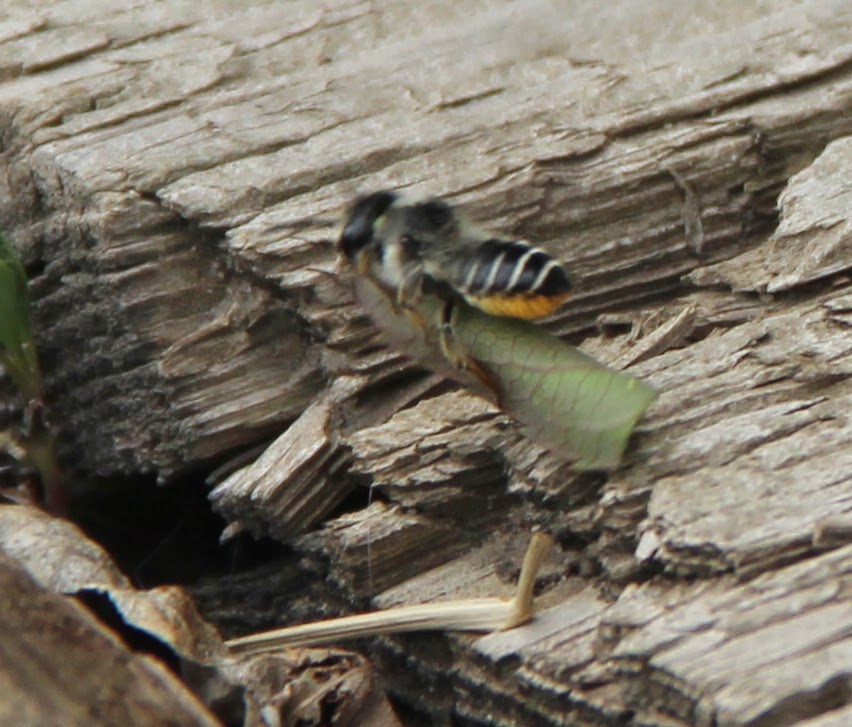Every summer since, I've hoped and looked for more leafcutter bees. Today I finally saw one. I was about to open the back door when I caught a glimpse of a funny-shaped insect flying around. I looked closer and realized it was a bee carrying a sizable piece of leaf, hence the odd shape. She entered a hole at the end of a railroad tie, and a few minutes later emerged without the fragment and flew off. She was gone for about five minutes before returning with another piece. In the meantime, I had grabbed the camera.
 |
| Entrance to nest is in the end of the shorter tie. |
The leaf fragments this bee brought back were larger than the ones I saw last time, and she had to fold them to carry them. Sometimes it seemed she had more than she could manage, and once she had to back out of the hole and take another shot at getting in with her load. But this is not an over-achiever bee. The bee in the photo below is carrying an equally large piece of leaf in the same manner.
 |
From Leafcutter Bees Fact Sheet, Colorado State University Extension.
|
This leafcutter bee either made longer trips or spent more time harvesting compared with the one I saw some years ago. She was gone for up to 10 minutes at a time, and finally didn’t return before I lost my patience and went inside.
Leafcutter bees are said to prefer certain kinds of leaves for their partitions -- green ash, lilac, Virginia creeper and rose. I looked at the rose bushes in the yard, and found some leaves with rounded cut-outs.
But I think these holes are too small. They may be the work of leafcutter bees, but apparently not the one I was watching.
Also the veins of the rose leaves don't match those of the bee’s leaf fragment. I wandered around the yard looking for the source plant, but no luck. You can bet I will be scanning the neighbors' trees and shrubs now for cut-outs as I walk through the 'hood.
 |
| Do you recognize the bee’s leaf? It has serrated margins and reticulate (net-like) purplish veins. (click on image for a better view) |
 |
Rose leaves also have serrated margins, but the veins are neither purplish nor reticulate.
|
Leafcutter bees are solitary bees (vs. colonial). The female lives only a few months and has a lot of work to do in that time. She either finds or excavates a linear site, and starts building one cell after another, stocking each with pollen and nectar for her offspring. She lays an egg in the cell and then seals it with a leaf fragment. In this way she constructs on the order of a dozen cells, in a tunnel 4-8” long. The young bees hatch, develop, and live in their chambers until the following summer (source).
Leafcutter bees generally do not remove enough leaf tissue to be destructive. And personally, I’d love to have lots of little round cut-outs in rose leaves if it meant more leafcutter bees in railroad ties.
 |
Leaves with bee nibbles. From Leafcutter Bees Fact Sheet, CSU Extension.
|





I love this! I've never heard of leaf-cutter bees.
ReplyDeleteThanks, Anne. I sure hope they become regular visitors, it's neat knowing the railroad ties are bee nurseries :-)
DeleteI see what you mean about the odd shape when she is carrying her leaf. Perhaps these are really witch bees and the leaves are their broomsticks?
ReplyDeleteah, Lucy -- always so insightful ;-) Thanks for the comment -- and the chuckle.
Delete